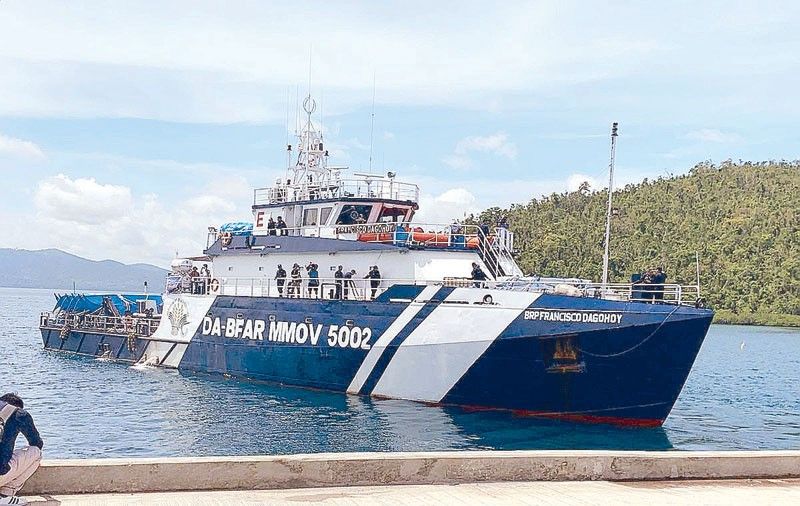Shadowed by China ships, PCG ferries aid to Pag-asa

PUERTO PRINCESA, Philippines — The civilian patrol vessel of the Bureau of Fisheries and Aquatic Resources (BFAR),BRP Francisco Dagohoy, yesterday embarked on a 28-hour mission to Pag-asa Island, ferrying P5 million worth of materials to help local fishermen get more catch.
The ship’s commanding officer confirmed that Philippine vessels were being shadowed and receiving radio challenges from the Chinese Coast Guard (CCG) when passing disputed waters of the West Philippine Sea.
The Philippine Coast Guard (PCG) and BFAR are bringing fishing gear such as fish stalls, fish containers, plastic
floaters, twine, lead sinkers and deep sea payao, as well as post-harvest equipment such as blast freezer, ice coolers, industrial weighing scales, crate storages, seawater flake ice machine and a generator set to the community.
In an interview with members of media, including The STAR, BRP Francisco Dagohoy commanding officer Lt. Cdr. Mark Adrias said that aside from rough seas toward Pag-asa Island, he expects another radio challenge from the CCG.?“Based on the track we prepared, we will pass the Sabina (Escoda) Shoal going to Pag-asa Island, so we expect a radio challenge from the Chinese Coast Guard as they are present in the area,” Adrias added.?It has become normal for the CCG to shadow Philippine vessels in the area, according to the official.
“Usually, when we are passing, the Chinese Coast Guard, especially in areas they occupy, they shadow us, or there are radio challenges. They do it purposely for us to prevent (us from) going to the 12 nautical miles they set where they currently occupy these,” he said.
He added that based on the guidance given to him, necessary documents are gathered for the filing of appropriate protest.
“The role of the coast guard is to conduct footage, recordings of the radio challenges for the filing of continuous diplomatic protests,” Adrias said.?Despite the scenario becoming the norm in the disputed West Philippine Sea area, he gave assurance that the PCG will continue to assert the right of the country in its occupied territories.
Adrias also noted that fisherfolk in Pag-asa Island experience similar incidents when passing near Chinese-occupied territories.
“The Chinese Coast Guard calls their attention when crossing the 12 nautical miles they set,” he said.
In a separate interview, BFAR spokesman Nazario Briguera said the mission to Pag-asa Island coincided with the celebration of the 125th Philippine Independence Day to make it more meaningful – by helping fisherfolk in Pag-asa Island to free themselves from poverty as residents from the lone barangay in the municipality of Kalayaan are among the poorest in the country.
“Pag-asa Island, as part of Kalayaan municipality, is still new in terms of development compared to mainland municipalities as first, the access to technologies is very limited, the area being remote, but we will not stop providing assistance not only in Pag-asa Island, but also in coastal communities,” Briguera added.
He disclosed that the BFAR would provide P4.95 million worth of equipment and capacity-building programs to two fisherfolk groups in Pag-asa Island.
Meanwhile, BFAR national director Demosthenes Escoto expressed optimism that through the initiative, Pag-asa Island fisherfolk will be further equipped with tools and skills to increase their catch in the resource-rich waters.
“This voyage, which aims to provide livelihood support for residents and fisherfolk of Pag-asa Island, is one of our initiatives in accordance with the order of President Marcos to strengthen our support for the fisheries sector as well as far-flung communities,” Escoto said.
Once they reach Pag-asa Island, BFAR personnel will also conduct training seminars on proper fish handling, good manufacturing practices and sanitation standards for the fishing community, particularly the Kalayaan Palawan Farmers and Fisherfolks Association and the Spratlys Strong and Brave Women Association.
Escoto said the bureau is also considering giving additional livelihood inputs to Filipino fisherfolk in the West Philippine Sea and adjacent areas to boost production.
The BFAR has been augmenting the fishery activities operating and situated in the area, especially those in Pag-asa Island, through the provision of fiber-reinforced plastic boats and hand lines, payao and lambaklad fishing technologies, marine engines and post-harvest equipment to local fisherfolk. — Bella Cariaso
- Latest
- Trending



























